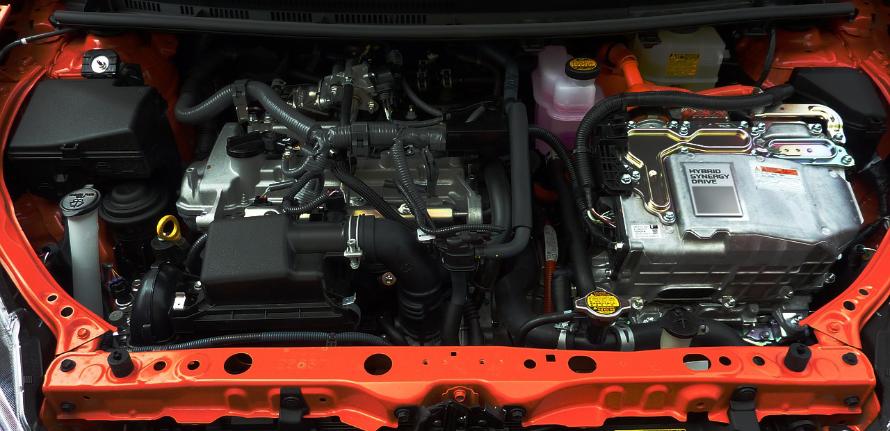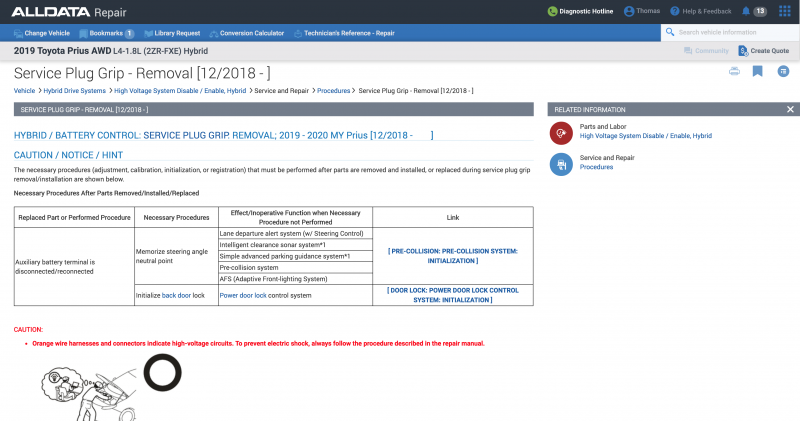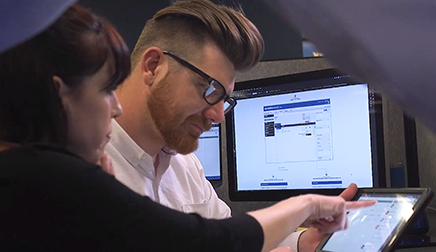

BEWARE OF HYBRID HAZARDS
With sales of hybrid electric vehicles (HEVs), plug-in hybrid electric vehicles (PHEVs), and especially electric vehicles (EVs) on the rise, is it likely you will see one in your service drive for repairs? The answer is definitely, “yes.” According to a report from the Edison Electric Institute in Washington, D.C., more than 1.18 million EVs alone were on the road as of March 2019. Total electric vehicle sales were up 81% in 2018 over 2017.
What concerns us in the automotive repair and collision industries is that HEVs, PHEVs, and EVs are inherently dangerous to work on. However, for those with the proper training and the manufacturer’s repair information, the risks can be negligible.
Following OEM repair procedures is critical to repairing hybrid and electric vehicles safely and efficiently, whether you obtain those procedures from organizations like I-CAR or NFPA or a subscription-based online source for automotive OEM information, like ALLDATA.
The U.S. Department of Energy tells us that hybrid and full-electric vehicles undergo the same rigorous safety testing as conventional vehicles sold in the U.S. and need to meet federal motor vehicle safety standards. Manufacturers must design hybrid and electric vehicles with insulated high-voltage cables and safety features that deactivate the electrical system when they detect a collision severe enough to deploy the airbags or a short circuit. Although these safety measures may be adequate to help protect drivers when they crash their hybrid or electric vehicles, there is a long list of serious safety issues to be concerned with when those damaged vehicles enter a collision shop for repairs.
Safety Information and Education
As the total number of HEVs, OHEVs, EVs and alternative fuel vehicles (AFVs) on U.S. roadways exceeds 13 million, training and OEM information has become an essential part of a first responder’s day to day activities. For collision shops that want to repair these vehicles safely and efficiently, education and dependable information also play a key role.
A reliable and comprehensive source for OEM hybrid and electric vehicle information and training can be found on the Inter-Industry Conference on Auto Collision Repair’s (I-CAR) website. The courses I-CAR offers are specific to the collision industry and are available with additional benefits, important repair information and certifications as part of their Repairability Technical Support (RTS) program.
Also available as part of the RTS program subscription is access to I-CAR’s OEM Hybrid and Electric Vehicle Disable Search matrix. This easy-to-use guide will help you quickly identify where parts of the hybrid system are located, how to disable the hybrid system before repairs begin, and best practices to help ensure a complete, safe, and high-quality repair. The matrix is updated frequently to reflect the latest information from the auto makers.

Another trusted resource for OEM safety information is provided by the National Fire Protection Association (NFPA). The organization is working closely with 35+ auto makers to help prepare the nation's fire service and other first responders for the growing number of alternative fuel vehicles on the road. Their website contains manufacturer-specific Emergency Response Guides, which prove very helpful in identifying and understanding the safety measures necessary to safely work around all types of alternative fuel vehicles. The guides are free to view or download and are updated as the manufacturers provide more information.
The NFPA Emergency Response Guides can be used as a quick-reference source for helpful information such as: the best methods of disconnecting the high-voltage system, the type and location of the batteries, air bag and inflator cylinder locations, identifying a vehicle’s construction materials, and high-voltage cable and component locations.
Following OEM repair procedures is critical to repairing hybrid and electric vehicles safely and efficiently, whether you obtain those procedures from organizations like I-CAR or NFPA or a subscription-based online source for automotive OEM information, like ALLDATA.
Two Safety Tips
Battery Damage
Let’s say a tow truck driver drops a hybrid/electric vehicle on your service drive. You asked the driver if the first responder and/or the tow truck driver had disabled the high-voltage system. Even though they verified that they did, another danger may be lurking in the form of a damaged high-voltage battery.
It’s always a good idea to do an immediate and thorough inspection of the batteries when a hybrid or electric vehicle arrives. Although the high-voltage system was disabled at the scene, during the transition to your shop, a battery could have ruptured and begun to leak electrolyte or entered a dangerous thermal runaway event. Both situations can be extremely dangerous.
Nickel Metal Hydride Battery - Leaking Hazard
Nickel Metal Hydride (NiMH or Ni–MH) batteries can cause an explosion. Although a leaking lead acid battery is corrosive and dangerous because of its acid content, NiMH batteries are alkaline, and when their electrolyte leaks onto aluminum, that produces hydrogen gas, which can explode easily with the slightest spark. Even if the battery is not leaking, the area surrounding the vehicle should be well-ventilated and all electrical sources – including the high-voltage and 12-volt batteries – should be disconnected with the cable ends insulated to avoid an accidental arc.
Lithium Ion Battery - Thermal Runaway
There are warning signs that a damaged lithium ion battery is experiencing a thermal runaway event. If you detect any of the following issues, clear the area and call the fire department immediately:
- Fluid Leaks
- Sparks
- Smoke
- Flames
- Increased temperature
- Hissing, gurgling, or popping noises
Be Sure It’s Really Off!
Most hybrids have some kind of "Ready" indicator light on the dash to alert the driver that the hybrid system is on. Always make sure to push the “Power” button (if equipped) to turn the vehicle off, check to be sure the “Ready” light is out, the ignition is off, and the key is out and away from the vehicle before you start any service or repair work. Removing the key from the vehicle is especially important if the vehicle has a keyless entry system and recognizes the key fob anytime it’s close to the car. Keep key fobs in a safe place at least 20 feet away from the vehicle to prevent any accidental starts.
Here’s why – if the power is on, the high voltage system is live and poses a shock hazard should you come into direct contact with any of its uninsulated electrical components such as the inverter under the hood. Also, while parked, many hybrid vehicles revert to an electric-only mode of operation, shut off the gasoline engine, and make no noise. Meanwhile, the engine control module continues to monitor the voltage of the hybrid battery and may automatically restart the engine if the hybrid battery voltage is low and the engine needs to run to recharge it. That could prove very hazardous if you are working under the hood, changing the oil, or doing anything else that puts you near belts, pulleys, or high voltage components.
Look for more hybrid and electric vehicle tips from ALLDATA in the coming months. Be safe!
ALLDATA Collision builds on the industry-leading mechanical information found in ALLDATA Repair, adding OEM procedures such as section and structural repairs, handling of new materials, and panel removal and replacement. Request a demo of ALLDATA Collision by calling (888) 853‑7309 or click here to get started.






